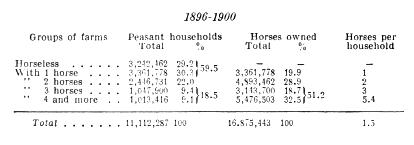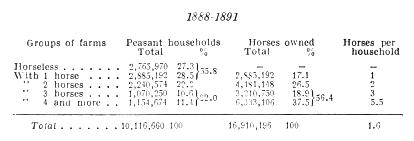
The army-horse censuses of 1896 and 1899-1900 enable us now to compare the latest data with those quoted above.
By combining the 5 southern gubernias (1896) with 43 of the rest (1899-1900), we get the following data for 48 gubernias of European Russia:

For 1888-1891 we cited data for 49 gubernias. Of these, the latest data are lacking only for one, namely, Archangel Gubernia. Subtracting the figures for this gubernia from those given above, we get for the same 48 gubernias in 1888-1891 the following picture:

A comparison of 1888-1891 and 1896-1900 reveals the growing expropriation of the peasantry. The number of households increased by nearly 1 million. The number of horses diminished, although very slightly. The number of horseless households increased with particular rapidity, and their percentage rose from 27.3 to 29.2. Instead of 5.6 million poor peasants (horseless and one-horse), we now have 6.6 million. The entire increase in the number of households has gone to enlarging the number of poor ones. The percentage of households rich in horses diminished. Instead of 2.2 million households with many horses, we have only 2 million. The number of middle and well-to-do households combined (with 2 and more horses) remained almost stationary (4,465,000 in 1888-1891 and 4,508,000 in 1896 1900).
Thus the conclusions to be drawn from these data are as follows.
The increasing poverty and expropriation of the peasantry is beyond doubt.
As for the relation of the top group of the peasantry to the bottom one, this remained almost unchanged. If, in the manner described above, we constitute the bottom groups of 50% of the households and the top groups of 20% of the households, we shall get the following: in 1888-1891 the poor, 50% of the households, had 13.7% of the horses. The rich, 20% of the households, had 52.6%. In 1896-1900 the poor, 50% of the households, also had 13.7% of the total peasant-owned horses, while the rich, 20% of the households, had 53.2% of the total number of horses. Consequently, the relationship between the groups remained almost unchanged.
Lastly, the peasantry as a whole became poorer in horses. Both the number and the percentage of the many-horse households decreased. On the one hand, this evidently marks the decline of peasant farming generally in European Russia. On the other hand, one must not forget that the number of horses employed in agriculture in Russia is abnormally high for the area cultivated. It could not be other wise in a small-peasant country. The drop in the number of horses consequently represents to a certain degree “the restoration of the normal proportion between the number of draught animals and the amount of arable” among the peasant bourgeoisie (see Mr. V. V.’s arguments on this point above, in Chapter II, § 1).
It will be appropriate here to touch on the arguments on this question in the latest works of Mr. Vikhlyayev (“Sketches of Russian Agricultural Reality,” St. Petersburg, published by the magazine Khozyain[Farmer]) and of Mr. Chernenkov (A Characterisation of Peasant Farming, Part I, Moscow, 1905). They were so carried away by the diversity of the figures on the distribution of horses among the peasantry that they turned economic analysis into a statistical exercise. Instead of studying the types of peasant farm (day labourer, middle peasant, entrepreneur), they make a study, like amateurs, of endless columns of figures, just as though they have set out to astonish the world by their arithmetical zeal.
Only thanks to such play with figures was Mr. Chernenkov able to fling the objection at me that I am “prejudiced” in interpreting “differentiation” as a new (and not old) and for some reason completely capitalist phenomenon. Mr. Chernenkov was, of course, free to think that I was drawing conclusions from statistics and forgetting economics!—that I was proving something from a mere change in the number and the distribution of horses! To view intelligently the differentiation of the peasantry, one must take the picture as a whole: the renting of land, the purchase of land, machines, outside employments, the growth of commercial agriculture, and wage-labour. Or maybe Mr. Chernenkov considers these also are neither “new” nor “capitalist” phenomena?
| | |
| | | | | | |